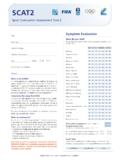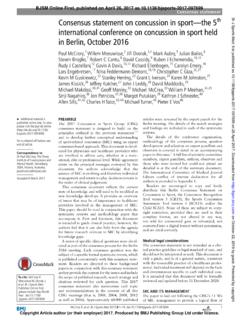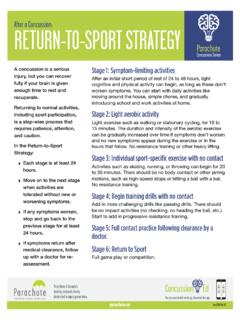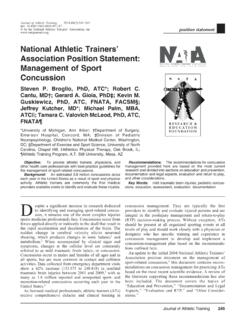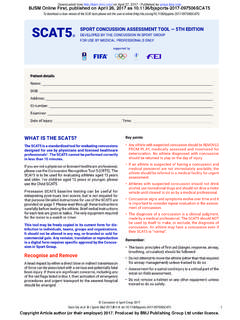Transcription of Child SCAT5 SPORT CONCUSSION ASSESSMENT TOOL
1 862 Davis GA, et al. Br J sports Med 2017;51:862 869. CONCUSSION in SPORT Group 20171 Davis GA, et al. Br J sports Med 2017;0:1 8. SCAT5 CONCUSSION in SPORT Group 2017 Child SCAT5 WHAT IS THE Child SCAT5 ?The Child SCAT5 is a standardized tool for evaluating concussions designed for use by physicians and licensed healthcare you are not a physician or licensed healthcare professional, please use the CONCUSSION Recognition Tool 5 (CRT5). The Child SCAT5 is to be used for evaluating Children aged 5 to 12 years. For athletes aged 13 years and older, please use the SCAT5 . Preseason Child SCAT5 baseline testing can be useful for interpreting post-injury test scores, but not required for that purpose. Detailed instructions for use of the Child SCAT5 are provided on page 7.
2 Please read through these instructions carefully before testing the athlete. Brief verbal instructions for each test are given in italics. The only equipment required for the tester is a watch or tool may be freely copied in its current form for dis-tribution to individuals, teams, groups and organizations. It should not be altered in any way, re-branded or sold for commercial gain. Any revision, translation or reproduction in a digital form requires specific approval by the Concus-sion in SPORT and RemoveA head impact by either a direct blow or indirect transmission of force can be associated with a serious and potentially fatal brain injury. If there are significant concerns, including any of the red flags listed in Box 1, then activation of emergency procedures and urgent transport to the nearest hospital should be detailsName: DOB: Address: ID number: Examiner: Date of Injury: Time: Key points Any athlete with suspected CONCUSSION should be REMOVED FROM PLAY, medically assessed and monitored for deterioration.
3 No athlete diagnosed with CONCUSSION should be returned to play on the day of injury. If the Child is suspected of having a CONCUSSION and medical personnel are not immediately available, the Child should be referred to a medical facility for urgent ASSESSMENT . CONCUSSION signs and symptoms evolve over time and it is important to consider repeat evaluation in the assess-ment of CONCUSSION . The diagnosis of a CONCUSSION is a clinical judgment, made by a medical professional. The Child SCAT5 should NOT be used by itself to make, or exclude, the diagnosis of CONCUSSION . An athlete may have a a CONCUSSION even if their Child SCAT5 is normal .Remember: The basic principles of first aid (danger, response, airway, breathing, circulation) should be followed.
4 Do not attempt to move the athlete (other than that required for airway management) unless trained to do so. ASSESSMENT for a spinal cord injury is a critical part of the initial on-field ASSESSMENT . Do not remove a helmet or any other equipment unless trained to do so CONCUSSION ASSESSMENT TOOLFOR CHILDREN AGES 5 TO 12 YEARSFOR USE BY MEDICAL PROFESSIONALS ONLY supported byTo download a clean version of the SCAT tools please visit the journal online ( ) CONCUSSION in SPORT Group on August 4, 2017 - Published by from 863 Davis GA, et al. Br J sports Med 2017;51:862 869. GA, et al. Br J sports Med 2017;0:1 8. SCAT5 CONCUSSION in SPORT Group 2017 Child SCAT5 WHAT IS THE Child SCAT5 ?The Child SCAT5 is a standardized tool for evaluating concussions designed for use by physicians and licensed healthcare you are not a physician or licensed healthcare professional, please use the CONCUSSION Recognition Tool 5 (CRT5).
5 The Child SCAT5 is to be used for evaluating Children aged 5 to 12 years. For athletes aged 13 years and older, please use the SCAT5 . Preseason Child SCAT5 baseline testing can be useful for interpreting post-injury test scores, but not required for that purpose. Detailed instructions for use of the Child SCAT5 are provided on page 7. Please read through these instructions carefully before testing the athlete. Brief verbal instructions for each test are given in italics. The only equipment required for the tester is a watch or tool may be freely copied in its current form for dis-tribution to individuals, teams, groups and organizations. It should not be altered in any way, re-branded or sold for commercial gain. Any revision, translation or reproduction in a digital form requires specific approval by the Concus-sion in SPORT and RemoveA head impact by either a direct blow or indirect transmission of force can be associated with a serious and potentially fatal brain injury.
6 If there are significant concerns, including any of the red flags listed in Box 1, then activation of emergency procedures and urgent transport to the nearest hospital should be detailsName: DOB: Address: ID number: Examiner: Date of Injury: Time: Key points Any athlete with suspected CONCUSSION should be REMOVED FROM PLAY, medically assessed and monitored for deterioration. No athlete diagnosed with CONCUSSION should be returned to play on the day of injury. If the Child is suspected of having a CONCUSSION and medical personnel are not immediately available, the Child should be referred to a medical facility for urgent ASSESSMENT . CONCUSSION signs and symptoms evolve over time and it is important to consider repeat evaluation in the assess-ment of CONCUSSION .
7 The diagnosis of a CONCUSSION is a clinical judgment, made by a medical professional. The Child SCAT5 should NOT be used by itself to make, or exclude, the diagnosis of CONCUSSION . An athlete may have a a CONCUSSION even if their Child SCAT5 is normal .Remember: The basic principles of first aid (danger, response, airway, breathing, circulation) should be followed. Do not attempt to move the athlete (other than that required for airway management) unless trained to do so. ASSESSMENT for a spinal cord injury is a critical part of the initial on-field ASSESSMENT . Do not remove a helmet or any other equipment unless trained to do so CONCUSSION ASSESSMENT TOOLFOR CHILDREN AGES 5 TO 12 YEARSFOR USE BY MEDICAL PROFESSIONALS ONLY supported byTo download a clean version of the SCAT tools please visit the journal online ( ) CONCUSSION in SPORT Group 2017 CONCUSSION in SPORT Group 20172 Davis GA, et al.
8 Br J sports Med 2017;0:1 8. SCAT5 CONCUSSION in SPORT Group 20172 IMMEDIATE OR ON-FIELD ASSESSMENTThe following elements should be assessed for all athletes who are suspected of having a CONCUSSION prior to proceeding to the neurocognitive ASSESSMENT and ideally should be done on-field after the first first aid emergency care priorities are any of the Red Flags or observable signs are noted after a direct or indirect blow to the head, the athlete should be immediately and safely removed from participation and evaluated by a physician or licensed healthcare of transportation to a medical facility should be at the discretion of the physician or licensed healthcare GCS is important as a standard measure for all patients and can be done serially if necessary in the event of deterioration in conscious state.
9 The cervical spine exam is a critical step of the immediate ASSESSMENT , however, it does not need to be done 1: RED FLAGSSTEP 2: OBSERVABLE SIGNSW itnessed Observed on Video Lying motionless on the playing surfaceYNBalance gait difficulties motor incoordination: stumbling, slow laboured movementsYNDisorientation or confusion, or an inability to respond appropriately to questionsYNBlank or vacant lookYNFacial injury after head traumaYNSTEP 3: EXAMINATIONGLASGOW COMA SCALE (GCS)2 Time of assessmentDate of assessmentBest eye response (E) No eye opening 111 Eye opening in response to pain 222 Eye opening to speech 333 Eyes opening spontaneously 444 Best verbal response (V)No verbal response 111 Incomprehensible sounds 222 Inappropriate words 333 Confused 444 Oriented 555 Best motor response (M)No motor response 111 Extension to pain 222%bnormal flexion to pain 333*lexion ;ithdrawal to pain 444 Localizes to pain 555 Obeys commands 666 Glasgow Coma score (E + V + M)CERVICAL SPINE ASSESSMENTDoes the athlete report that their neck is pain free at rest?
10 YNIf there is NO neck pain at rest, does the athlete have a full range of ACTIVE pain free movement?YNIs the limb strength and sensation normal?YNIn a patient who is not lucid or fully conscious, a cervical spine injury should be assumed until proven OR OFF-FIELD ASSESSMENTSTEP 1: ATHLETE BACKGROUNDP lease note that the neurocognitive ASSESSMENT should be done in a distraction-free environment with the athlete in a resting team school: (ate time of injury: Years of education completed: Age: +ender: 1 * Other (ominant hand: left neither rightHow many diagnosed concussions has theathlete had in the past?: When was the most recent CONCUSSION ?: How long was the recovery (time to being cleared to play)from the most recent CONCUSSION ?))





